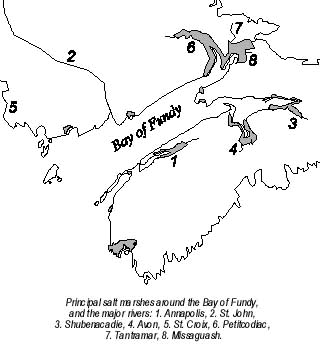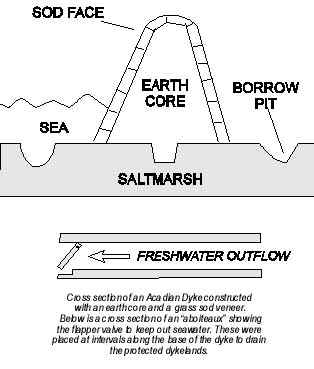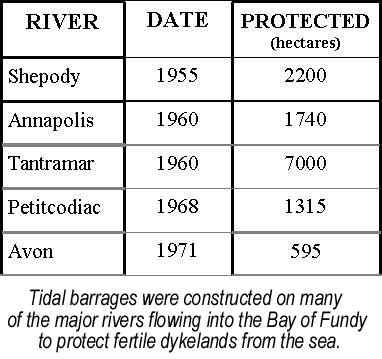AUTUMN 1996
DYKES, DAMS AND DYNAMOS:
The impacts of Coastal Structures
"great quantities of marsh, meadows, and low ground ......
in the Bay of Fundy ...... are spoiled by overflowing of the sea ....
which by industry may be greatly improved".
Maritime mudscapes
In lower intertidal areas that are underwater most of the time, the sediment layers form soft, sticky mudflats, that are rather bare, save for a thin film of microscopic marine algae growing on the surface. Higher up, in areas that are out of the water for longer periods, several species of tough land plants eventually manage to secure a foothold. These can tolerate regular immersion in salt water and soon spread widely over the mudflat, thrusting their roots deep into the sediment to exploit the abundant nutrients. These roots bind the sediments tightly in their tangled net and keep the swirling waters from washing it away. In addition, the protruding stems act like miniature snow fences in a blizzard, breaking the force of the currents and allowing the suspended sediments to accumulate in tiny "mud drifts". The marsh plants thus trap as well as hold the sediments, allowing the saltmarsh to slowly increase in size. The most abundant and effective of these plants is cord grass (Spartina alterniflora), which can survive long periods of submersion in salt water. Higher up the marsh, in areas that are submerged only occasionally, grow black grass, marsh sedge and glasswort; while spurrey, goose tongues and seaside golden rod garnish the uppermost fringes. This rapidly growing marsh vegetation continually releases fragments of dead and decaying organic matter into the water. This provides food for large populations of intertidal invertebrates and fertilizes the nearshore waters with organic matter and nutrients. In fact, the saltmarshes contribute almost a third of the productivity of the marine ecosystem in the upper Bay.
The largest tracts of salt marshes fringe the upper Bay, particularly the head of Chignecto Bay and the southern shore of Minas Basin. Large marshes also occur along the Annapolis Basin and River, around the Chebogue Meadow near Yarmouth and the Musquash Estuary South of Saint John, NB. When the Acadians first arrived in the early 1600's, there were more than 35,700 hectares (88,200 acres) of productive salt marshes scattered around the Bay. Most have long since been wrested from the sea, with seemingly far-reaching consequences for the marine ecosystem of the Bay of Fundy.

Acadian agriculture
Dykes to dams
 the 1920's the bubble burst, as the internal combustion engine replaced horses
and the demand for hay plummeted. By the 1930's much of the dykeland lay unused and miles
of dykes went unrepaired. The sea had already recaptured some marsh and increasingly
threatened thousands more hectares of prime farmland. A period of exceptionally high tides
was in the offing, and governments worried that "the region would lose tens of
thousands of hectares of prime farmland that had taken three centuries to create".
Thus, during the 1940's the federal and provincial governments launched a modest program
(Maritimes Dykelands Rehabilitation Committee) to assist with dyke restoration. Modern,
mechanized equipment, such as bulldozers, backhoes and draglines, rumbled to the defense
of the dykes for the first time. However, it quickly became clear that a much larger
coordinated effort would be needed to hold back the sea effectively. Thus the Maritime
Marshland Reclamation Administration (MMRA) was launched in 1948. Over the next 20 years
some 373 kilometres of dykes protecting over 33,000 hectares (81,500 acres) of farmland
were repaired or constructed.
the 1920's the bubble burst, as the internal combustion engine replaced horses
and the demand for hay plummeted. By the 1930's much of the dykeland lay unused and miles
of dykes went unrepaired. The sea had already recaptured some marsh and increasingly
threatened thousands more hectares of prime farmland. A period of exceptionally high tides
was in the offing, and governments worried that "the region would lose tens of
thousands of hectares of prime farmland that had taken three centuries to create".
Thus, during the 1940's the federal and provincial governments launched a modest program
(Maritimes Dykelands Rehabilitation Committee) to assist with dyke restoration. Modern,
mechanized equipment, such as bulldozers, backhoes and draglines, rumbled to the defense
of the dykes for the first time. However, it quickly became clear that a much larger
coordinated effort would be needed to hold back the sea effectively. Thus the Maritime
Marshland Reclamation Administration (MMRA) was launched in 1948. Over the next 20 years
some 373 kilometres of dykes protecting over 33,000 hectares (81,500 acres) of farmland
were repaired or constructed.
Just as the early Acadians drew heavily on European experiences in wresting the valuable dykelands from the sea, governments in the 1950's again turned to Europe for guidance in protecting them. Holland had recently experienced devastating floods and had fought back with a massive program of dam building to regulate tidal flows in almost all rivers and estuaries. A visiting delegation of Maritime government officials was impressed with what it saw there, and returned full of enthusiasm for a comparable approach to taming Fundy's unruly rivers. Thus, during the 50's and 60's the MMRA embarked on a major program to control most of the large rivers around the Bay with tidal barrages (see table). These served to protect upstream farmland from tidal flooding and did away with the need for frequent, costly repairs to miles of riverside dykes. At the time, little if any, consideration appears to have been given to the possible environmental consequences of blocking all these tidal rivers.
Dams to dynamos
The environmental effects
Dykes - The Acadian dykes, and those constructed in the intervening years, have unquestionably had a significant effect on the dynamics of sediments in the Bay of Fundy. The massive quantities of sediments that are in the upper reaches of Fundy are in a constant state of change and movement. Accumulation as mudflats and marshes in certain places, and steady erosion in other places are indicative of continuous shifts in the balance of the oceanographic and other processes that deposit the sediments and those that erode them away. Even a relatively modest change in the direction or strength of a tidal current, can over time, cause drastic changes in the structure of the mudflats or marshes. Not all of these intricate balances are fully understood by the scientists who study such things. They are often hard pressed to predict what effect the construction of a breakwater or a causeway will have on the distribution and shape of nearby mudflats and marshlands. It is no wonder then, that it has been virtually impossible to say with any certainty what the Bay of Fundy would have been like if Acadian settlers had not engaged in their ambitious dyke building along its shores all those centuries ago. What is clear, however, is that the subsequent dyke building and barrage construction set up barriers to the huge quantities of fine grained sediments, which would normally have been deposited in slowly accumulating thin layers over thousands of hectares of productive salt marshes.
Studies in recent decades have shown that the coastal marshes were hardly "spoiled by the overflowing of the sea". They are not only highly productive ecosystems in their own right, but they are also an important part of a mutually beneficial association with coastal waters. The sea fertilizes the marshes with a continuous supply of nutrient rich sediments. The marshes in their turn supply abundant organic food and soluble nutrients to the coastal waters. The constant production of fragments of salt marsh vegetation adds huge amounts of organic matter to the surface layers of the mud in the saltmarshes and nearby mudflats. This provides ample food reserves for huge numbers of benthic invertebrates such as amphipods, worms and shellfish that sustain the large numbers of migrating shorebirds that stop over in the upper reaches of Fundy each year. A lot of the decaying vegetable matter is also swept into the shallow coastal waters, where it serves as food for a wide range of abundant marine invertebrates and fish. Scientists from Acadia University, Bedford Institute of Oceanography and elsewhere, who have studied present day rates of production of plant material (primary production) by the phytoplankton of the water column, the diatoms of the mudflats and the grasses of the saltmarshes have concluded that the marshes produce 25-30% of the total production of the inner Bay.
It is estimated that of the 35,700 hectares of salt marsh present at the time of European settlement, only 5-6,000 hectares remain today, a remnant 16%. According to Graham Daborn "it is a matter of conjecture how much more productive these waters would have been when the marshes were intact and six times as extensive." Unfortunately, we shall probably never know, because too many other things have changed over the centuries. But Daborn is confident that "in all likelihood, the progressive conversion of saltmarsh to dykeland, carried out in piecemeal fashion over time, has substantially reduced the productive potential of the tidal bays in favour of increasing agricultural land." Only we humans who dwell on Fundy's shores can judge whether the trade off has been worth it.
Dams - The many tidal rivers and their estuaries that flowed unimpeded into the Bay of Fundy were well known for the annual migrations of large numbers of fish such as salmon, striped bass, tom cod, sturgeon, eels and several species of herring. The construction of causeways across most of these rivers presented a formidable barrier to the migrating fish. Fishways were incorporated in some of these structures and early studies suggest that these permitted some of the fish to bypass the obstacles, but there can be little doubt that the barriers have severely disrupted spawning migrations. During the past few decades many of these prolific fish runs have been all but eliminated. However, it has proven difficult to directly link the decimation of the fish populations to the presence of the causeways because of a lack of adequate environmental studies prior to their construction. Also, even before this there had been a steady degradation of spawning habitat in most rivers and streams as a result of upstream hydroelectric and other dams, as well as a century or more of destructive forestry and agricultural practices.
By shutting out the normal tidal flow, the causeways also significantly changed the ecology of the rivers for a considerable distance upstream. Researchers from Acadia University found that the "biological communities, which remained rich and abundant in the tidal regime below the dam, were impoverished upstream". Strict control of water height at much higher mean levels also eliminated much of the intertidal zone and converted well mixed water masses into highly stratified (layered) ones. Increased streambank erosion occurred in many places and silt began to settle in the impoundments, instead of being swept out into the estuary. The barriers have also had profound effects on the distribution of mudflats and saltmarshes downstream in nearby coastal areas. An example of their dramatic effect on estuaries is clearly visible from the highway on the causeway across the Avon River near Windsor, Nova Scotia. In the 27 years since its construction, a large bank of reddish-brown mud has formed downstream. This has steadily expanded down the river, until its effects are now evident in the form of a pronounced shallowing of the estuary at Hantsport, 8 kilometres away. In the past few years, spreading patches of marine grasses indicate that the mudflat is slowly evolving into a new saltmarsh. A similar phenomenon occurred following construction of a causeway across the Petitcodiac River at Moncton, NB. In the Annapolis Basin there are strong suspicions that the construction of the causeway across the river, or the subsequent installation of the tidal power plant, caused marked changes in the nature of surface sediments around much of the Basin, with disastrous effects on the clam fishery.
Dynamos - The huge spinning blades of the tidal power turbines have proven to be a particular hazard for migrating fish, in spite of the presence of nearby fishways offering safe passage. Studies on shad suggested that the majority pass through the turbines on their way downstream; less than 1% used the fishways. Over half of those passing through the turbines were killed. Two thirds of them were killed as a result of sudden changes in water pressure during the passage, while a third of them had been hit by the large spinning blades. Surveys by scuba divers in the Basin below the plant revealed large numbers of dead and dismembered fish littering the bottom. As a result the area has become a popular hang out for seals and seagulls in search of a quick and easy ready-processed fish dinner. Researchers concluded that "the mortality rates of both adult and juvenile fish are far higher than originally expected" and that the tidal power plant imposes "a continuing steady mortality on already stressed populations during their migration". A wide range of fish species, including salmon, herring, striped bass and sturgeon appear to be effected to varying degrees. Unfortunately, the spinning turbines are only one of many environmental stresses that have contributed to the gradual destruction of most fish stocks in the Annapolis, and nearly all other Fundy rivers. Researchers have been hard pressed to determine with any confidence, the importance any one stress factor by itself in reducing the fish populations.
Reducing repercussions
Further Reading
Potential impacts of hydro and tidal power developments on the ecology of bays and estuaries. G.R. Daborn. Pages 334 -348 In: Environmental Consequences of Energy Production: Problems and Prospects. Edited by S.K. Majumdar, F.J. Brenner and E.W. Miller. The Pennsylvania Academy of Science. 1987.
Update on the marine environmental consequences of tidal power development in the upper reaches of the Bay of Fundy. Edited by D.C. Gordon, Jr. and M.J. Dadswell. Canadian Journal of Fisheries and Aquatic Sciences. Volume 1256. 1984.
Observations on the ecological importance of salt marshes in the Cumberland Basin, a macrotidal estuary in the Bay of Fundy. D.C. Gordon, Jr., P. J. Cranford and C. Desplanque. Estuarine and Coastal Shelf Science. Volume 20, pages 205-207. 1985.
Maritime dykelands. The 350 year struggle. The Province of Nova Scotia, Department of Agriculture and Marketing. 110 pages. 1987.
Mortality of juvenile clupieds during passage through a tidal, low-head hydroelectric turbine at Annapolis Royal, Nova Scotia. K.D.E. Stokesbury, and M.J. Dadswell. North American Journal of Fisheries Management. Volume 11 pages 149-154. 1991.
Cause and Effect. M.Higgins and D. Jeffery. Nature Canada. Volume 25 Number 4 pages 25-28. Autumn 1996.
Written and produced by J.A. Percy
The Clean Annapolis River Project, P.O. Box 395, Annapolis Royal, Nova Scotia B0S 1A0
Tel: (902)532-7533 Fax: (902)678-1253 e-mail: shawboldt@fox.nstn.ns.ca
The Bay of Fundy Ecosystem Project is supported by Environment Canada,
the Department of Fisheries and Oceans Canada
and the Acadia Centre for Estuarine Research.
This publication is financially supported by the Gulf of Maine Council on the Marine
Environment.
It may be reproduced with credit to the Clean Annapolis River Project.